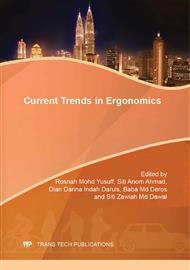[1]
Badrie, S., Hermanto, M. Z. Perbaikan Rancangan Produk Yang Memenuhi Kriteria Ergonomis, Seminar Nasional Ergonomi. Yogyakarta. (2004)241-250.
Google Scholar
[2]
Belavendram, N. Quality By Design-Taguchi Techniques for Industrial Experimentation. Maylands Avenue, UK, Prentice-Hall International, (1995).
Google Scholar
[3]
Bridger, R. S. Introduction to Ergonomics. Singapura. McGraw-Hill Inc, (1995).
Google Scholar
[4]
Carayon-Sainfort, P. dan Smith, M. J. Impact of Computer System Performance on Task Characteristics and Worker Stress. Dalam Bullinger, H.J. (Ed. ). Proceedings of the Fourth International Conference on Human Computer Interaction. 2. Tokyo : Elsevier. P : 693 – 698. (1991).
DOI: 10.1080/10447319209526041
Google Scholar
[5]
Grandjean, E, Fitting the Task to the Man. 4th ed. London : Taylor & Francis Inc. (1993).
Google Scholar
[6]
Harwita, F. E. Pencahayaan dalam Industri. Pelatihan Hiperkes bagi Dokter Perusahaan. Medan : Kanwil Depnakestran Sumatera Utara, (1993).
Google Scholar
[7]
Hendrawan, A., Suharyana, Kusuma, N. I. Pengaruh Tingkat Pencahayaan Terhadap Kelelahan Kerja Pada Tenaga Akunting Hotel Berbintang di Yogyakarta. Prosiding Seminar Nasional Ergonomi. Yogyakarta. Universitas Gajah Mada, (2003).
DOI: 10.5614/j.ergo.2018.3.1.1
Google Scholar
[8]
Lum-i-neering Associates. Lighting Design Handbook. Port Hueneme. Calif : Civil Engineering Laboratory. Dept. of the Navy. (1979).
Google Scholar
[9]
Manuaba, A. Ergonomi, Kesehatan dan Keselamatan Kerja. Editor : Sritomo Wignyosoebroto dan Stefanus Eko Wiranto. 2000. Prosiding Seminar Nasional Ergonomi 2000. Surabaya : Guna Wijaya. Hal : 1-4 (2000).
Google Scholar
[10]
Niosh dalam swarmadhika. Penggunaan Filter Layar Monitor Menurunkan Beban kerja dan Meningkatkan Produktivitas Operator Komputer. Jurnal Ergonomi Indonesia. Vol. 2 No. 1. Denpasar: Program Studi Ergonomi-Fisiologi Kerja UNUD. Hal. 20-23. (2001).
DOI: 10.24843/jei.2016.v02.i02.p02
Google Scholar
[11]
Nurmianto, E. Ergonomi, Konsep Dasar dan Aplikasinya. Jakarta. PT Guna Widya. (1996).
Google Scholar
[12]
Nuswantoro, Y. Analisis Pengaruh Postur Kerja dan Stasiun Kerja Terhadap Kenyamanan Operator Komputer dengan Metode Visual Display Terminal (VDT) Workstation pada Software ErgoEASER. Skripsi S1 Teknik Industri UII Yogyakarta (Unpublished). (2006).
DOI: 10.14710/jati.12.1.15-22
Google Scholar
[13]
Phesant, S. Ergonomics, Work and Health. London : Mcmillan Press Scientific & Medical. (1991).
Google Scholar
[14]
Purbawati. Pengaruh Cahaya Terhadap Waktu Kerja Operator. Prosiding Seminar Nasional Ergonomi. Yogyakarta . Universitas Gajah Mada. (2003).
Google Scholar
[15]
Purnomo, H., M. Y. Dewantara, R. N. Palilingan. Penilaian Performansi Operator Komputer. Prosiding Seminar Ergonomi. Denpasar. Universitas Udayana. (2006).
Google Scholar
[16]
Roestijiwati, N. Sindrom Dry Eye pada Pengguna Visual Display Terminal (VDT). Jurnal Cermin Dunia Kedokteran. Jakarta. YARSI. No. 154. (2007).
Google Scholar
[17]
Sastrowinoto, S. (1985). Meningkatkan Produktivitas dengan Ergonomi. Jakarta. PT. Pustaka Binaman Pressindo.
Google Scholar
[18]
Suci, C. J. Pengaruh Intensitas Cahaya, Warna Display, dan Jenis Huruf Terhadap Performansi Kerja Operator Komputer. Skripsi S1 Teknik Industri UII Yogyakarta (Unpublished). (2007).
Google Scholar
[19]
Suma'mur. Norma-norma Penerapan Ergonomi yang Disepakati (The Recomemmended Ergonomic Norms). Jakarta. Pusat Hiperkes Tenaga Kerja. (1986).
Google Scholar
[20]
Sutalaksana, Iftikar Z. Teknik Tata Cara Kerja. Departemen Teknik Industri. Bandung. ITB. (1979).
Google Scholar
[21]
Tayyari, F. and Smith, J.L. Occupational Ergonomics, Principles and Applications. London : Chapman & Hall. (1997).
Google Scholar
[22]
Wignjosoebroto, S. Ergonomi, Studi Gerak dan Waktu: Teknik Analisis Untuk Meningkatkan Produktivitas Kerja. Surabaya : Guna Widya. (1995).
Google Scholar
[23]
Woodson, W. E., Tillman, B., and Tillman, P. Human Factors Design Handbook (2nd ed. ). New York: Mcgraw-Hill. (1991).
Google Scholar


